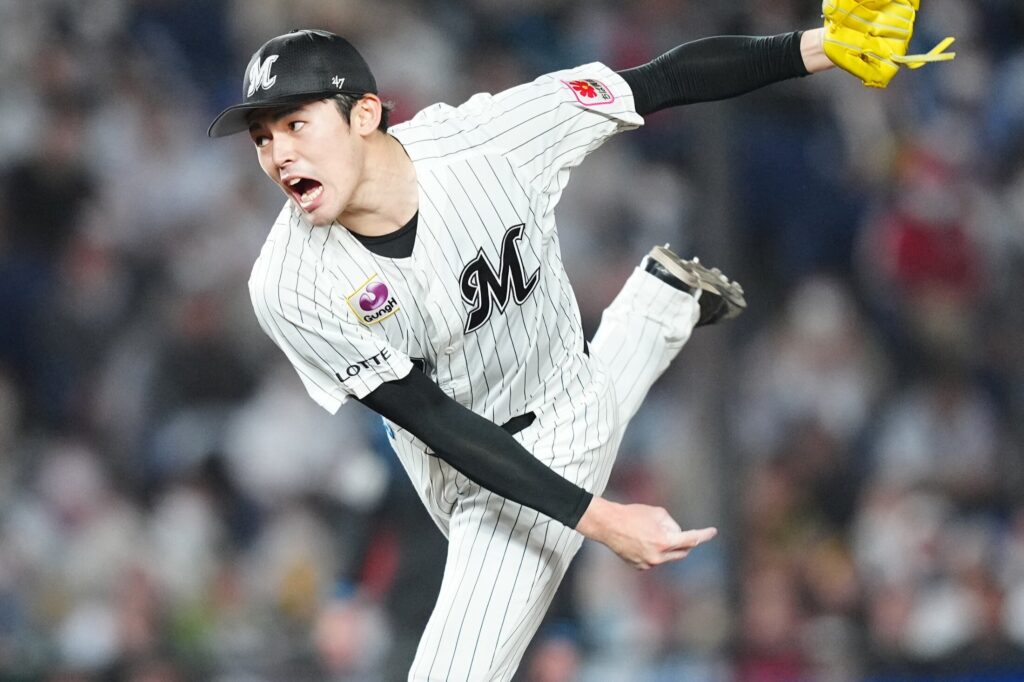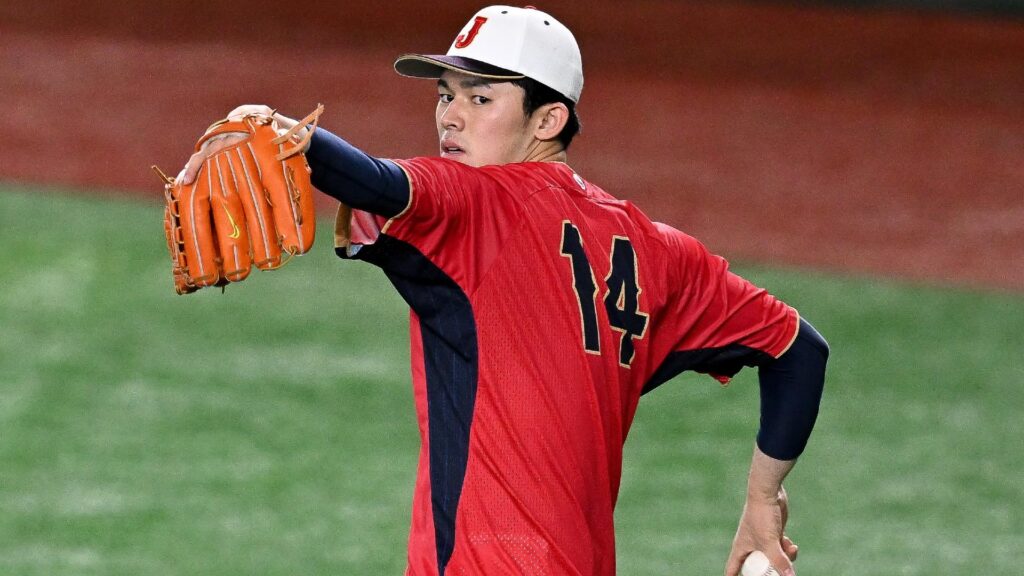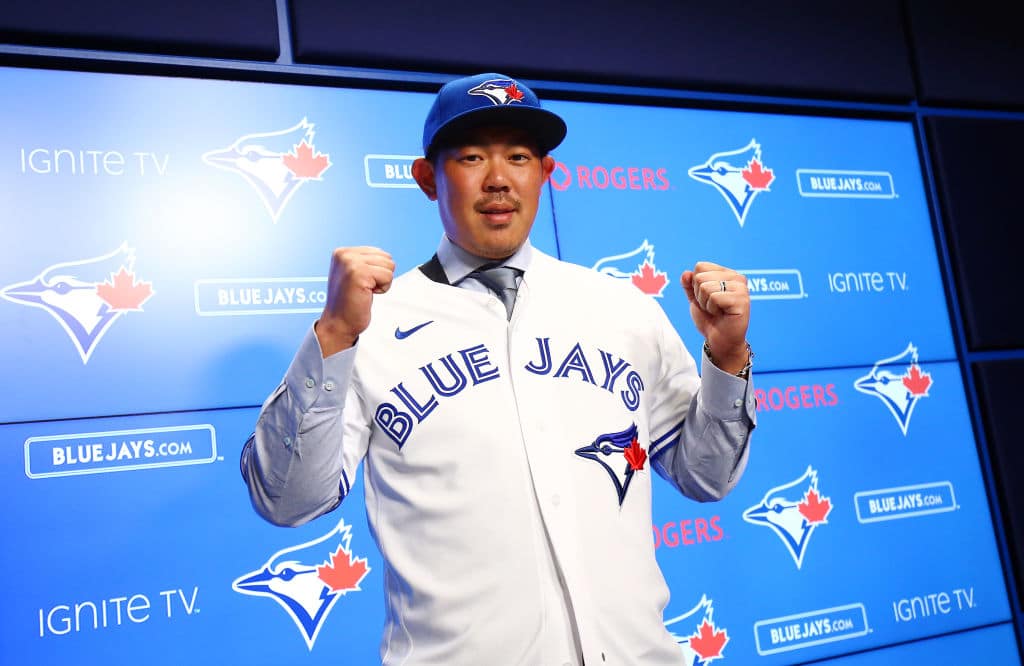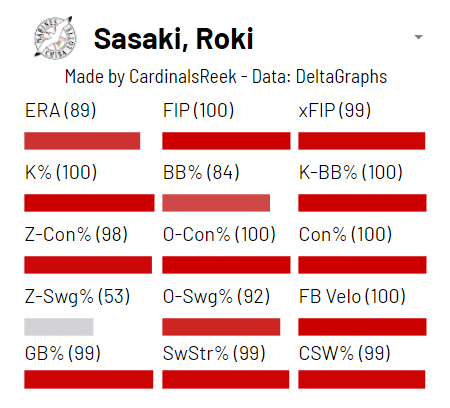
There is growing speculation that 22-year-old pitching wunderkind Roki Sasaki will make a move to Major League Baseball after the 2024 season. Previously, it was believed that Sasaki would be posted by his Nippon Professional Baseball team, the Chiba Lotte Marines, after the 2026 season when he will be 25 years old and no longer subject to international bonus pool money restrictions. When that time comes, Sasaki would be expected to get paid upwards of $300 million, like his Samurai Japan counterpart, Yoshinobu Yamamoto, who just received the biggest contract ever for a pitcher in MLB history (12 years, $325 million). In the process, the Marines would receive an enormous posting fee approaching or exceeding $50 million — more than doubling their current team payroll.
However, new developments this winter suggest Sasaki may transfer stateside far sooner than initially expected. On December 10, Sponichi abruptly reported that Sasaki had asked to be posted to MLB this current offseason. It just so happened to be that this was also the day that Shohei Ohtani signed the biggest contract in North American sports history (10 years, $700 million), but this report did not add up for several reasons: 1) It was already mid-December when most players are posted in late November or early December, 2) Sasaki had downplayed MLB aspirations in the past, and 3) no other media outlets had corroborated the statement. As journalist Jim Allen points out, however, there’s more to the story than just a bogus report, and multiple MLB sources indicate that Sasaki was indeed asking to be posted…next year, after the 2024 season. Sponichi possibly misinterpreted the information to mean Sasaki wanted out right now.

Still, if the rumors are indeed true, this is a significant development in Sasaki’s future. A potential move to MLB in the 2024-2025 offseason would indicate that he is limited to a minor league contract and thus the Marines would receive very little financial compensation for posting him. Logically, if Sasaki and Lotte wanted to maximize his market value, this would seemingly rule out the posting happening so soon as the team would need to agree to it. Further, it is considered customary for a Japanese player to put together a successful NPB resume — including winning awards, titles, and championships — before asking to be posted. Sasaki has yet to accomplish any of these things. Many teams view the posting system as a “reward” and are typically free to deny transfers if a player’s contributions are deemed inadequate. The SoftBank Hawks, for instance, maintain a ‘no posting’ policy and will not even consider it, much to the frustration of stars like Kodai Senga, who had to wait until reaching international free agent eligibility after nine whole years of service. The Seibu Lions also rejected Kona Takahashi’s posting request earlier this offseason.
That said, there are always special cases, and there are agreements behind closed doors that the public will never learn. Under the current NPB-MLB agreement — first established in 1998 following the controversial MLB signings of Hideo Nomo, Hideki Irabu, and Alfonso Soriano — players under 25 years of age are restricted to minor league contracts, eliminating nearly all of the financial incentive a Japanese team may have for posting a young superstar. Yet, two-way unicorn Ohtani was posted by the Nippon-Ham Fighters in 2017 at the age of 23. Admittedly, the circumstances surrounding Ohtani and Sasaki are different as Ohtani had initially declared a move to the United States straight out of high school, and, per the existing NPB-MLB agreement, the Los Angeles Angels paid Nippon-Ham a $20 million flat posting fee despite him only signing a minor league deal with a $2.315M signing bonus (the maximum the Angels were permitted to give). When the Fighters surprisingly drafted Ohtani in 2012, the team agreed to a clause that effectively allowed Ohtani to be posted whenever he pleased. Though the formality and exact details of the clause are unknown, it was a compromise in order to convince Ohtani to start his career in NPB. Shun Yamaguchi also reportedly had an exit clause worked into his contract, enabling the Yomiuri Giants to shockingly break their ‘no posting’ policy in 2019.

According to the LA Times, Sasaki is thought to have a similar agreement in place with the Marines. Bunshun — a weekly tabloid magazine — also echoed this in a recent report on January 16, which added credence to Sponichi’s report from a month prior, claiming that the source was a business associate of Sasaki’s family with connections to Yoshinobu Yamamoto. Though there is no evidence for any of this, it is reasonable to assume such information would be kept private and that a player of Sasaki’s caliber would ask for such a clause considering MLB scouts had targeted him in high school. If Sasaki desired to keep his options open for the future, it would have been smart for him to negotiate a posting agreement after the Marines won the draft lottery for him in 2019. If Lotte did not agree to it, they would have risked wasting their first-round selection entirely, as NPB does not reward compensation picks when a draftee fails to sign, unlike MLB (e.g., Kumar Rocker and Mets in 2021).
Of course, Sasaki’s personal priorities at this moment are unknown. But after playing alongside legendary superstars like Ohtani and Yu Darvish in the 2023 World Baseball Classic, it is plausible that he wants to fast-track his path to MLB, even if it costs him hundreds of millions of dollars in the short term. Regardless, for Sasaki to be posted, the Marines must agree to it, which is only possible if he indeed has a right to leave that has not been made public. As the Marines are yet to win a pennant with Sasaki, posting him with zero financial return would be a tough pill to swallow. Moreover, Sasaki’s early departure could set a dangerous precedent for NPB becoming a mere “feeder league” for MLB. Nevertheless, the scenario is becoming a distinct possibility and things that appear to defy logic on the surface cannot be ruled out because Roki Sasaki himself is a player who defies logic, like Ohtani and Nomo. Just the idea that he might go to MLB sooner than expected is noteworthy.
Whether 2024 is Sasaki’s final year wearing a Marines uniform or not, the expectations for the flamethrower are through the roof. Sasaki is a once-in-a-generation talent not just in Japan, but the entire world. The term “video game numbers” doesn’t even scratch the surface of what Sasaki has managed since making his NPB debut in 2021 at age 19. He set an NPB record with 17 consecutive perfect innings and 52 straight batters retired in 2022, including a 19 strikeout Perfect Game on April 10, 2022. Across 283.2 career innings over 46 starts, Sasaki has posted a 2.00 ERA, 1.67 FIP, 0.84 WHIP, and 13.7 WAR. His ridiculous strikeout-to-walk ratio of 376-56 gives him 11.9 K/9 and 1.8 BB/9, or collectively a 29.3 K-BB%. For context, Yoshinobu Yamamoto has a career K-BB% of 20.5% in NPB and Jacob deGrom has a career K-BB% of 25.2% in MLB. Even when compared to the greatest aces like Ohtani and Senga who already made the jump to MLB, Sasaki’s utter dominance is apparent.
| Player | Years | Starts | ERA | FIP | FIP- | K% | BB% | K-BB% | HR% | BAA |
|---|---|---|---|---|---|---|---|---|---|---|
| Shohei Ohtani | 2014 – 2017 | 71 | 2.30 | 2.56 | 64 | 30.3 | 8.7 | 21.6 | 1.04 | .194 |
| Kodai Senga | 2015 – 2022 | 151 | 2.59 | 3.26 | 81 | 27.9 | 9.2 | 18.7 | 2.06 | .208 |
| Yoshinobu Yamamoto | 2017 – 2023 | 118 | 1.75 | 2.31 | 60 | 26.7 | 5.8 | 20.9 | 0.97 | .197 |
| Roki Sasaki | 2021 – 2023 | 46 | 2.00 | 1.67 | 47 | 34.4 | 5.1 | 29.3 | 1.18 | .181 |
Statistics shown do not include relief outings.
FIP- is Weighted Fielding Independent Pitching (100 = League-Average).
Sasaki has been nicknamed “The Monster of the Reiwa Era,” following in the footsteps of Suguru Egawa and Daisuke Matsuzaka, the Monster of the Showa and Heisei Eras, respectively. But what sets Sasaki apart from any other pitcher in NPB history is his velocity. Among MLB starting pitchers in 2023, Sasaki’s average fastball velocity of 98.9 mph would firmly place him second ahead of fellow flamethrowing phenom Hunter Greene and behind only Dodgers’ rookie Bobby Miller. His max fastball velo of 103 mph tied him with Shohei Ohtani for the fastest pitch by a Japanese player in NPB history. Having said that, Ohtani’s average velocity in NPB only ever reached 96.6 mph, so Sasaki’s ability to maintain 99+ mph for an entire game puts him in a league of his own. He regularly averages triple-digits for several innings in any given start and rarely throws a heater below 97 mph.
Sasaki’s fastball, however, is not his premier weapon. That honor goes to his forkball/splitter, which Aram Leighton of JustBaseball.com referred to as “the easiest 80 grade I’ve ever given out.” It accounted for 64% of his 135 total strikeouts in 2023, and opposing hitters batted under .100 against the pitch. He has allowed just two homers on the fork in his NPB career, and it helped him generate an NPB-best 62% groundball rate in 2023. He also possesses a slider which is hit-or-miss depending on the day but provides him a much-needed third pitch to keep hitters guessing. Sasaki sought help from veteran Darvish during the 2023 WBC to change the characteristics of the pitch from a more traditional gyro slider to a sweeper but is still a work in progress. If he refines it further, he could elevate his game to yet another level, though it is already adequate as he has two other elite pitches.
| Pitch Type | Usage % | Average Velocity | Runs Above Average Per 100 Pitches | Swinging Strike % | BAA |
|---|---|---|---|---|---|
| Fastball | 50.5 | 98.9 | +1.21 | 11.7 | .227 |
| Forkball | 35.3 | 89.5 | +1.66 | 29.9 | .098 |
| Slider | 14.0 | 87.6 | +0.53 | 18.3 | .188 |

When it comes to his on-field ability, the only question remaining with Sasaki is his health and durability. He did not pitch at all in 2020, focusing on strength and conditioning in his first year as a professional. He made 16 starts between NPB and the farm in 2021 but only went more than six innings on two occasions. He pitched a career-high 129.1 frames in 2022 but became fatigued in the second half and ran out of gas, as two-thirds of his total innings came in the first half. In 2023, he was remarkable for 13 starts to open the season but suffered a torn oblique muscle in July and made just three short starts to end the year, including three perfect innings in the playoffs. Since 2021, Sasaki has averaged just over 15 starts and 94 innings a season, raising serious concerns about whether a lanky 6-foot-2 flamethrower can handle a bigger workload. On the flip side, his lower workload could be viewed as a positive when compared to the likes of Nomo and Matsuzaka, who were overworked in their youth. Sasaki has yet to sustain a major arm injury.
Whatever happens, Sasaki’s 2024 campaign should be one for the ages. Barring unforeseen circumstances, it will either be his final year in NPB or an epoch in his reign as the #1 pitcher in Japan (now that Yamamoto has crossed the Pacific). While the Marines will surely continue to manage his workload, Sasaki is the type of competitor who has what it takes to help carry his team to a pennant and leave a lasting legacy in Chiba. Above all, what fans want to see most from Sasaki is a full healthy season, which would all but guarantee him the all-time single-season K/9 record. There is a mix of excitement and uncertainty for the future but all that can be done now is to wait and see.

